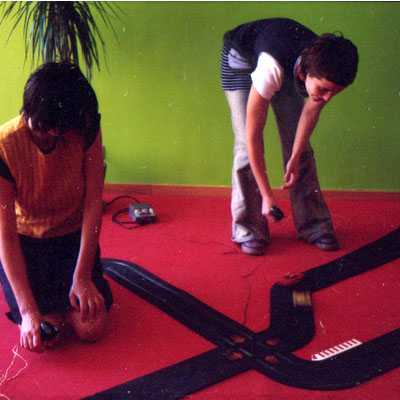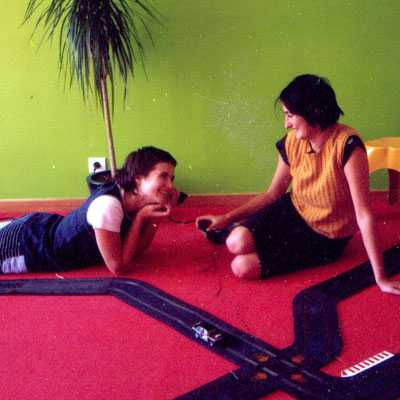A toda velocidad
The excitement of a new toy is ephemeral. Once we have recovered our sight after the flash produced by the joyful colours of it being presented to us, and we have experienced the concatenation of new sensations that are mainly based on small motor successes, we begin to measure our new pastime in terms of the obstacles that it places before us. We assign a potential level of entertainment to it that is inversely proportional to the difficulty with which we save each new inconvenience it offers us.
“At Full Speed” is structured in the following way: the video presents us with a still image of a section of toy racing car tracks. Two photographs accompany the recording. In one of them, the two players are laughing in a friendly manner during a break in the game; and in the other, the players are waiting to start the race.
In the words of its creator: “The race reflects movement as something that is occurring. Whatever you do, your performance is movement, your performance is achieved upon a mobile base.”
Toni Ramón converts his own introspection into an amplifier of attitudes and inabilities, of nerves and mistrust, of protocols of behaviour in personal relationships in which we are invited to recognise them. What’s more, in a sibylline way he marks for us the gateway into the space of our learning of relationships via a series of games and entertainment inherent in one generation. During the playing of these games, many learn what will later be the rules of their own games. They have also learnt to manage their own resources in order to achieve the best performance from the game of social relationships. Nietzsche once said: “Man's maturity: to have regained the seriousness that he had as a child at play.” (Beyond Good and Evil, 1885)
Under a shaped aesthetic kindness, the artist evokes the obvious pleasure of the ability to play, but he spurs us on with a less placid thought: all games require a loser.
The two protagonists of “At Full Speed” laugh without any cares while their cars are still, but when the race is on, they are concentrated on how it unfolds. It is during this moment that the inter-relationship between the players achieves a stronger connection, although it seems that they are ignoring each other, given that at that moment they are competing, or at least playing at competing. As if there were no competitiveness today in conceptual artistic creation? Aren’t there winners and losers in contemporary art?
Whether artists like it or not, they are immersed in a reality that is circumstantial to their generation, and from this they extract cultural elements that condition their expressive attitudes. Their work must interact in this reality. At times it denounces it while at other times it transmits hope.
“I would like to talk about my happiness as I am able to do about my sadness, without fear of doing so.”
These are good reasons to start playing again.
Bogdan Rutkiewicz




